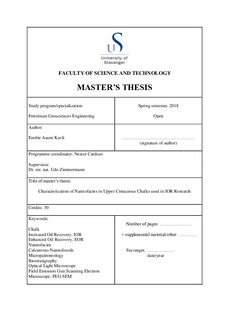| dc.contributor.advisor | Zimmerman, Udo | |
| dc.contributor.author | Kavli, Emilie Aasen | |
| dc.date.accessioned | 2018-11-02T09:41:25Z | |
| dc.date.available | 2018-11-02T09:41:25Z | |
| dc.date.issued | 2018-07 | |
| dc.identifier.uri | http://hdl.handle.net/11250/2570737 | |
| dc.description | Master's thesis in Petroleum Geosciences Engineering | nb_NO |
| dc.description.abstract | The aim of this thesis is to contribute to enhanced oil recovery (EOR) research by characterizing nannofacies in chalk samples used in increased oil recovery (IOR) flooding experiments with a MgCl2 brine at reservoir conditions. The objectives were achieved by combining optical light microscopy (OLM) with field emission gun scanning electron microscopy (FEG-SEM). The studied samples are of Cretaceous age and from onshore Denmark, Belgium and USA, as well as an offshore section from the Tor field in the North Sea. Five flooded equivalents of the onshore samples were analysed to determine how the nannofacies are both influenced by flooding and controlling it.
Calcareous nannofossil biostratigraphic analyses of the samples proved that some of the presumed ages were improper and in need of adjustments, especially the sample from Stevns Klint. General age data from open pit quarries might not be accurate and can be a pitfall when using onshore chalks as analogues to real reservoir chalks in EOR research. The samples displayed different calcareous nannofossil preservations and assemblages. The preservation level typically decreased one to two levels at the inlet position (closest to injection) after flooding. During flooding, certain species proved to be dissolution-resistant and others dissolution-susceptible. However, the assemblage composition could not predict MgO wt% after flooding. What might be able to predict it is total calculated nannofossil abundance from random settling smear slides, as well as estimated nannofossil versus micarbs ratios. Higher nannofossil abundance and lower micarb content in the original unflooded core yielded higher MgO wt% after flooding. More data is needed to verify this correlation. Results suggest that estimates of nannofossil versus micarb ratios from random settling smear slides trended to be 10-15% higher than estimates from the FEG-SEM. This might indicate that micarbs get dissolved during the random settling technique and hence, this technique might alter the sample - which should be taken into consideration when using this methodology.
The samples contained various paleoecological index nannofossils (indices). Paleoecological indices from all onshore samples except Aalborg point towards warmer waters with lower nutrient levels. In addition, evidence of the K/T extinction event might be observable in the offshore section. By combining changes in species diversity, nannofossil abundance and assemblage composition – it could be possible to indicate if the onshore samples have been sampled horizontally or vertically through the stratigraphy.
The methodologies and results described in this thesis proved to be of importance for the chalk characterization and might even to some extent be used to predict how chalk samples will react to IOR flooding experiments. These applied calcareous nannofossil methodologies should not be neglected but be included in future EOR research. This thesis’ work should be continued in the future, to further improve the methodologies and gain additional data to strengthen the results. | nb_NO |
| dc.language.iso | eng | nb_NO |
| dc.publisher | University of Stavanger, Norway | nb_NO |
| dc.relation.ispartofseries | Masteroppgave/UIS-TN-IER/2018; | |
| dc.subject | chalk | nb_NO |
| dc.subject | calcareous nannofossils | nb_NO |
| dc.subject | micropaleontology | nb_NO |
| dc.subject | biostratigraphy | nb_NO |
| dc.subject | increased oil recovery | nb_NO |
| dc.subject | petroleumsgeologi | nb_NO |
| dc.subject | petroleumsteknologi | nb_NO |
| dc.subject | petroleum geosciences | nb_NO |
| dc.title | Characterization of Nannofacies in Upper Cretaceous Chalks used in IOR Research | nb_NO |
| dc.type | Master thesis | nb_NO |
| dc.subject.nsi | VDP::Matematikk og Naturvitenskap: 400::Geofag: 450::Petroleumsgeologi og -geofysikk: 464 | nb_NO |
| dc.subject.nsi | VDP::Teknologi: 500::Berg‑ og petroleumsfag: 510::Geoteknikk: 513 | nb_NO |
